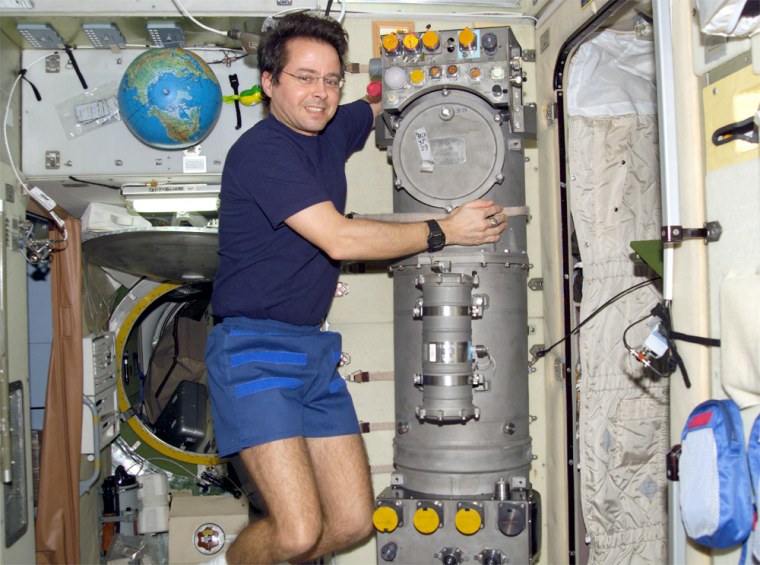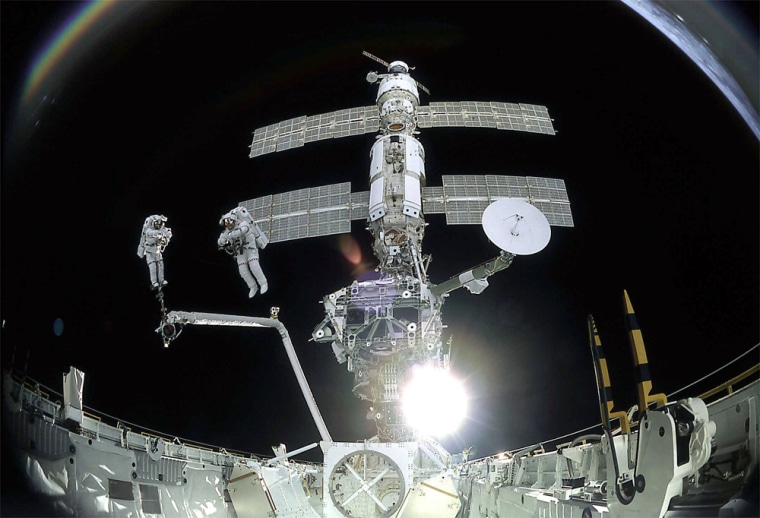The command from Mission Control was stark. The space station crew was to keep its oxygen generator running “at all costs” –- there were no more spare parts, and nothing but short-term backup procedures. If the equipment broke down again, as all its predecessors had, the mission would fail.
That's perhaps less dire than it sounds: In Earth orbit, a failed mission means the crew bails out and returns to Earth safely. But further out in space -- say, on the way to or from Mars, failure could spell death.
Thus, the new role envisioned for the international space station under President Bush's "space vision": as a place to practice hard above the ultimate safety net, Earth itself. Indeed, there are lessons to be learned already -- simply by looking back at the experiences of the current two-man crew aboard the space station.
Michael Foale and Aleksandr Kaleri are set to leave the station next month, but the challenges and accomplishments of their 6-month mission will have long-range significance. In particular, there are key lessons to be learned from the three major repairs they've performed while on board.
Case #1: The space gym
The treadmill aboard the space station is no ordinary health club model. The Treadmill Vibration Isolation System (TVIS) is a high-tech health maintenance and monitoring apparatus containing a computer-controlled gyroscopically-stabilized shock-isolated moving belt. Earlier this month, the crew completed a major repair of the TVIS, which had suffered a series of hardware glitches over the last three years.
“The treadmill was to be removed from the floor (the ‘pit’) and its chassis opened up to allow access to the roll-stabilizing gyroscope for removal of its flywheel,” a NASA internal status report stated. “The failed gyro bearings are then replaced, followed by reassembly of the gyro with careful torque calibration. This requires measuring shims and building a new shim stack, while verifying the running torque for the fasteners.”
Both crewmen worked two full days on this, “longer than expected” according to NASA. But in a message to the crew celebrating the completion of the repair, Mission Control indicated it understood the long-range significance of the success. "You are expanding the [In-Flight Maintenance] envelope,” the message wrote, “something that will be increasingly important as we plan and execute missions farther and farther from home."
Two lessons come to mind based on this experience. First, the TVIS unit was thoroughly designed and tested on Earth, but proved incapable of operating reliably over extended periods in space –- thus underscoring the critical need for in-space testing at full mission duration for any new equipment destined for future human missions heading out beyond hope of resupply.
Second, since equipment is known to fail anyway –- it’s a law of nature, not always evidence of inadequate engineering –- future crews need the diagnostic equipment, tools, and training to field-strip and reassemble anything on board, and the equipment needs to be built to be repaired.
Case #2: Keep on breathing
“The Elektron oxygen generator continues to be failed,” was a comment that repeatedly popped up in status reports earlier this month. The crew was faced with digging into their emergency supplies, or preparing to abandon the station, or -– getting the unit working again. The device uses electrical power to process waste water into gaseous oxygen for breathing.

After weeks of trying alternative procedures to nurse the device back into operation, the crew was told to use their last on-board spare unit. The Russians told NASA that the factory would not be able to produce another one until "sometime in 2005". On Saturday morning, March 20, the unit was turned on, and it’s been working fine ever since –- so far.
But a NASA source who requested his name not be disclosed told MSNBC.com they were not optimistic the device would last until a replacement unit could reach the station. The unit that failed had only been installed two months earlier.
“The sinking feeling is that there may be something systematic onboard that’s leading to the problem,” he stated.
It is clear that NASA must develop a long-term reliable oxygen-recycling system. Since anything that processes fluids will function differently on Earth from in space, it must be tested for years aboard the station before NASA can even begin to design a unit that a Mars crew must bet their lives on.
Case #3: Leaky window
Several weeks ago, the crew tried to restore their main science window to operational status by using pressure hoses to remove cabin air which had been introduced into the space between the window’s two main panes. The unwanted air threatened to contaminate the window with humidity, dust, and mold and required it stay closed most of the time.
A "flex hose" installed on the window was identified in January as the source of a small air leak that had bedeviled the crew for weeks. Engineers soon concluded that the damage to the hose had probably been caused by astronauts misusing the fragile structure as a handhold while looking out the window.
Foale accidentally compounded the problem when, to remove the hose and stop the leak, he detached the wrong end first. This allowed dirty cabin air to be sucked into the inter-pane volume that should be kept at a vacuum. Mission Control drew up a complicated procedure to remove the contamination.
After carefully training for this operation, the crew finally performed it on March 5. “The activity took longer than expected,” NASA’s status report stated, but “the crew did not observe any condensation” so the process seemed to be a success.
Meanwhile, alerted to the design flaw, engineers invented a ‘band-aid’. On March 15, they officially proposed building a ‘protective box’ for the new flex hose, since -– according to engineer Jon Maynard in a presentation obtained by MSNBC.com -– “crew-induced loads [were] the most likely root cause for [the] leak.”
Then, two weeks after the initial repair, according to another NASA status report, “Foale performed a leak check ... with the purpose to verify seal integrity.” Compared to a normal cabin pressure of 738 mmHg (millimeters of Mercury), the inter-pane volume had been lowered to near zero. But Foale found the pressure had risen to 359 mmHg – something was still leaking. Months of effort to undo a moment of human carelessness (atop a badly designed system) had apparently been in vain, and the use of the science window was again thrown into doubt.
The lesson here is like the old Southern proverb: “There’s no education in the second kick of a mule.”
After repeating a mistake made –- and later documented –- on Skylab about the hazard of delicate equipment near windows being misused as handholds, space station designers compounded the oversight by building a flex hose system that could be disconnected in the wrong sequence (Murphy strikes in orbit) -- and it was. Valuable time, and a valuable piece of equipment, has been expended uselessly. On the space station, operators had the luxury to accommodate this waste, but on the way to Mars or back, they won’t.
The value of breakdowns
All of these problems are not “bad news," rather they are ‘normal’ for a structure as complex as the space station. And if handled correctly, they actually are very “good news” indeed -– better to learn this stuff here near Earth, than halfway to Mars.
In Washington, the House Science committee held hearings on March 10 on the value of the the space station to NASA’s new exploration initiative. Many non-NASA speakers recounted the compromises and false hopes of the original project, and asked whether the money to be spent -- $60 billion for hardware and shuttle support through 2016, according to former NASA chief engineer Michael Griffin -– was justified.
But Lennard Fisk, chairman of the Space Studies Board at the National Academy of Sciences, approved the new purpose now assigned to the station.
“A permanent presence in low-Earth orbit in zero G will be essential,” he testified, “if we are in fact going to extend human presence beyond low-Earth orbit.”
Fisk, of course, assumed that the lessons of station operation would be applied to such missions, and that is now NASA’s responsibility.
